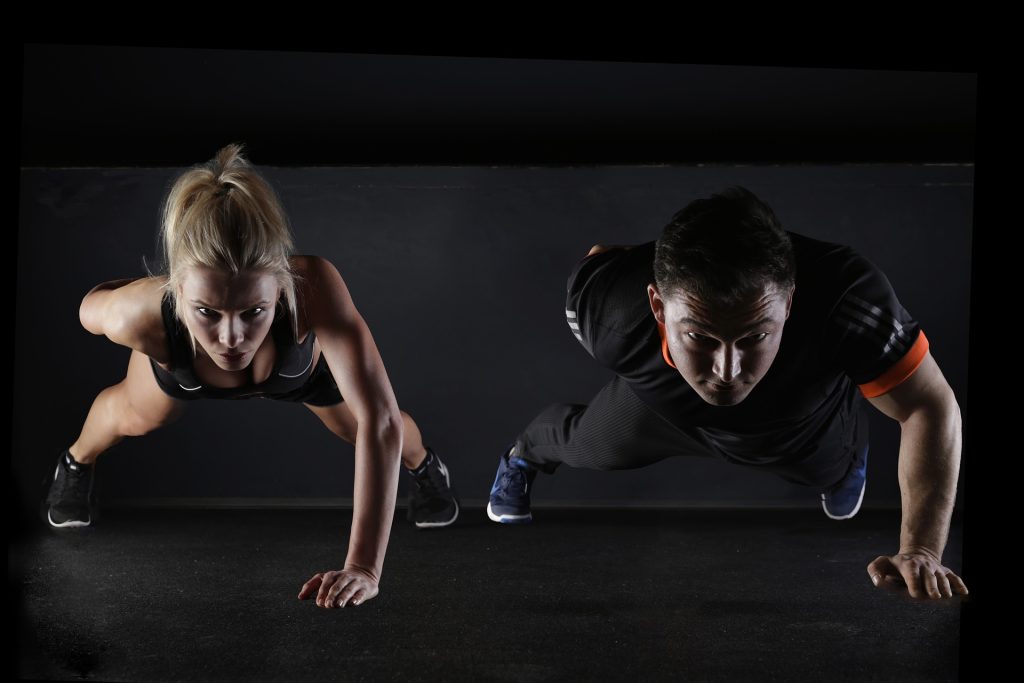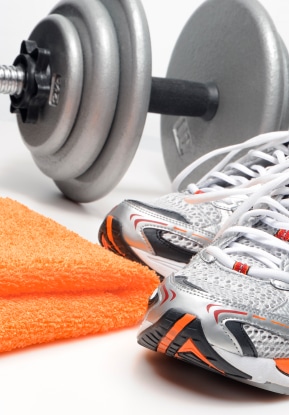
If you are going to exercise you may as well train for life. We all know we should be physically active. But, does it matter how you exercise? And, if so, how should you exercise?
We recommend that you exercise to train for life – to prepare for life. Life is a marathon, but it is a marathon of short bursts of activities both physically and mentally. You should train for life by incorporating short bursts of exercise into your training program. Your exercise program should translate to daily life. It should mimic it. It should reflect it.
Training Specificity
Personal trainers and strength and conditioning coaches discuss applying the principle of training specificity to a training program. You get what you do when you exercise. That’s a short way of summarizing the principle of training specificity.
A more scientific definition of training specificity is to train in a specific manner to produce a specific adaptation or training outcome. Therefore, if you want stronger muscles, lift weights. If you want to be a cyclist, train on a bike. If you want to be a long-distance runner run long distances, and perform sprints if you want to run short distances. Do agility drills if your sport or position requires rapid changes in directions.
So how should you train for life?
Life Versus Sports
To train for life we have to mimic life in our exercise program. Many say that life is a marathon. But if you analyze life more closely it differs from a marathon in some ways. A marathon is typically run at a constant pace or in a narrow range of the same pace. The pace in life varies dramatically.
Life is a bunch of short bursts of both physical and mental activity of varying intensities. Life is more similar to football and basketball in that regard. Let’s look at those two sports as they are similar yet different.
A football game (college and professional) is 60 minutes. But, it is not a continuous 60 minutes of activity. And, it would be unwise to train for football as if it were a game of continuous activity for 60 minutes. Football is a game of repetitive six to seven seconds of near maximal physical and mental effort.
This may surprise even the most diehard football fan, but the average NFL game has over 100 commercials and just 11 minutes of actual play. And, those 11 minutes take place over 3 hours and 12 minutes – the average length of a NFL game.
More time is spent watching replays – 17 minutes of replays – than actual play during a typical telecast. Over 75 minutes of a telecast involves watching coaches, players, and referees standing on the field and sidelines essentially doing nothing.
Basketball is different than football in that there is more consistent nonstop activity – just like life. In basketball we see some minimal baseline physical activity most of the time intermixed with bursts of physical activity and less standing around as in football.
Most of us probably live life somewhere between football and basketball.
Train for Life
Unless you are a competitive runner, we are pretty certain that real life is never going to demand that you run a continuous 26.2 miles (marathon distance). It is doubtful life will require you to even run 10 kilometers, unless you are in the military. And, probably the only time life will ever ask you to run 5 kilometers (about 3 miles) is if you find yourself fleeing from law enforcement.
So there really is no reason to run those distances for health and fitness purposes. They don’t translate to daily life. But if running is what you enjoy then by all means run as much as you want.
Yeah, but what about cardiovascular endurance, you ask? We will address that later.
If you want to run those distances because you enjoy it go ahead and continue to do so. But, doing so is not going to best prepare you for daily events. The muscle fibers you train running marathons will not help you get off the toilet when you are 70 or climb a flight of stairs or carry a heavy box.
But, here is what life is going to ask you to do – some of them nearly each day. These activities become increasingly more challenging the older we become. You will be asked to get out of a chair that has no arms. Many 70 year olds cannot do that. You will be asked to open heavy department store doors that many frail elderly cannot. You will be asked to carry something up and down stairs.
 You might be asked to sprint 30-40 yards to avoid a chasing dog, or worse an alligator, which are quite fast over that distance. You might have to fly down a flight of stairs to escape a house fire. You might have to lift the backend of car, or heavy tree limb that is pinning someone underneath.
You might be asked to sprint 30-40 yards to avoid a chasing dog, or worse an alligator, which are quite fast over that distance. You might have to fly down a flight of stairs to escape a house fire. You might have to lift the backend of car, or heavy tree limb that is pinning someone underneath.
And, you have to have a heart that can withstand the massive adrenaline surge associated with such life and death scenarios. It is the massive adrenaline surge associated with the fight or flight response that kills many. Is your heart trained to withstand a surge of adrenaline? Are you sure?
There is a good chance you will fall not because you are weak, or have poor balance, or are uncoordinated, but because accidents happen. They just do, and when they do, you have to have a strong enough body frame to withstand the force of impact.
Tripping over an uneven sidewalk, getting the feet tangled up in a dog’s leash, and tripping over a rug are the most common ways my patients fall. Plus, slipping on ice.
You have to train for short bursts by doing short bursts of exercise! That’s today’s message. Keep in mind the principle of training specificity. You get what you train for. When you look at most things you do throughout the day you will find that life is largely anaerobic – not aerobic. A six to seven second football play is a purely anaerobic activity. And, the scenarios we discuss above generally take no more than six or seven seconds. How long does it take to walk up a flight of stairs?
Okay, now that we have mentioned “aerobics” and “anaerobics” what do those terms mean?
Aerobics Versus Anaerobics
Now we have to get a little technical with the following discussion, but we will keep it simple as possible. A typical dictionary definition of “aerobics” is along the lines of pertaining to or caused by the presence of oxygen. And, that of “anaerobics” being pertaining to or caused by the absence of oxygen. More simply stated “aerobics” is with oxygen and “anaerobics” is without oxygen.
History of Aerobics

The use of the word “aerobics” to describe cardiovascular or endurance training was coined by my first boss (after completion of medical training), Kenneth Cooper, MD, PhD. As flight surgeon for the United States Air Force, Dr. Cooper developed many of the exercise programs and field tests used by the NASA, the military, and public schools. He also pioneered the executive health physical.
I wrote about the lessons I learned from Dr. Cooper in Magic of Thinking Big: Lessons From 2 Giants in Medicine. It is one of my favorite articles and the lessons I share can change a life – if you read it.
Dr. Cooper wrote his first book in 1968 simply titled Aerobics, which along with a couple of other simultaneous events started the fitness movement in this country and around the world. Dr. Cooper was convinced that aerobic exercise could “cure” nearly everything, and it clearly has tremendous health benefits. But, in the early to mid 1990s as he reached his 60s (born 1931) he realized the body needed more than aerobics. He recognized the need for strength training – the need to train for short bursts of activities.
For those of you who are runners, there is little reason to run beyond 12-15 miles a week from a cardiovascular endurance and general health perspective as there is little additional health and fitness benefit beyond that. That is based on Cooper Aerobics Center’s own research. More is not better.
Energy Systems of the Body
ATP (adenosine triphosphate) is the energy source the body runs on. ATP constantly needs to be produced or replenished.
Here’s an interesting fact I recently learned in my stem cell fellowship. The heart only contains enough stored ATP in its tissues to sustain ten heart beats. That’s it. It has to produce ATP on an ongoing basis. Cardiac cells are constantly producing ATP every second. Not surprising, cardiac cells contain the highest concentration of mitochondria per cell in the body – about 5,000 mitochondria per cardiac cell. Mitochondria are the organelles that produces ATP. Forty percent of a cardiac cell’s cytoplasm is mitochondria.
The body can produce ATP by using oxygen, but it can also produce ATP without oxygen. The body has three pathways to produce ATP. Two pathways do not require oxygen to produce ATP and one pathway does.
- ATP/CP Energy Pathway
- Glycolytic Pathway
- Oxidative Pathway
The oxidative pathway requires oxygen and produces much more ATP than the other two pathways. That might be the reason the oxidative pathway has garnered more attention than the other pathways and aerobic exercise more attention than anaerobic exercise.
How does the body choose which energy producing pathway it will use? It chooses the pathway based on the intensity of the exercise, which determines the duration of the activity. The body may use a combination of the three pathways to produce ATP depending on the activity.
ATP/CP Energy Pathway
This pathway is anaerobic. It is used in activities that require ballistic or explosive strength, or activities involving maximum effort for short duration. Throwing a shot put or baseball, running 100 meters, weightlifting and power lifting are examples. It is the starting pathway for all activity regardless of intensity, though. It is what get’s you out of bed so to speak. It’s the energy pathway that initiates activity.
The pathway requires CP or creatine phosphate which donates a phosphate group to ADP (adenosine diphosphate) to produce ATP. CP is stored in limited supply and dramatically drops after 10 seconds of exercise and is completely depleted within 60 seconds. It takes 8 minutes to completely replenish CP stores.
Football is an ATP/CP energy pathway sport but also requires the glycolytic pathway (next session) as the body cannot replenish CP stores fast enough to provide enough energy. ATP/CP is the energy pathway for activities lasting 1 to 60 seconds. A 100 meter sprint is almost exclusively an ATP/CP energy pathway event.
Glycolytic Pathway
The glycolytic pathway is also anaerobic. As we breakdown ATP/CP stores the body will begin to breakdown carbohydrates to convert ADP back into ATP while producing a waste product called lactic acid. Lactic acid builds up faster than it can be removed and eventually causes muscle fatigue. Reaching this point is called the anaerobic threshold. At this point you either have to stop an activity or slow the intensity giving the body a chance to remove lactic acid.
The glycolytic pathway kicks in shortly after any exercise is initiated, reaches a peak between 60 to 80 seconds and then rapidly declines by 100 to 120 seconds. It takes about an hour for lactic acid in the blood (not muscles) to return to normal after cessation of an activity.
The glycolytic pathway fuels activities lasting up to two minutes and uses carbohydrates.
Oxidative Pathway
Again, the oxidative pathway is aerobic. It uses oxygen. During the first two minutes of an activity the oxidative pathway slowly contributes more and more ATP with increasing duration and then becomes the sole energy producing pathway for activities lasting more than two minutes. The oxidative pathway is the only pathway that can burn fats. At lower levels of the oxidative pathways fats are preferentially burned, but at higher levels of the pathway carbohydrates are preferentially used to produce ATP.
The oxidative pathway is the sole energy producer for activities lasting more than two minutes and will burn fats and carbohydrates, and even protein if exercise is prolonged, and fats and carbohydrate stores depleted.
 Anaerobic Exercise
Anaerobic Exercise
Strength training and high intensity interval training (HIIT) are ways to train the anaerobic energy producing pathways. You have to train at 80% to 85% or more of your predicted heart rate to use the anaerobic pathways.
To calculate your predicted maximum heart rate subtract your age from 220 and then multiply that by 85%. So a 40 year old would have to exercise at an intensity to get his/her heart rate above 153 to be in the anaerobic training zone. Here’s the calculation: (220-40) times 0.85 = 153. They can train at a higher intensity if they want, but that is the minimum.
You cannot exercise in the anaerobic zone very long before fatiguing and that is the basis for high intensity interval training. High intensity interval training involves near maximal effort for 10 to 120 seconds getting your heart rate into the anaerobic zone followed by a break and repeated several times.
Remember way back up the article we mentioned the adrenaline surge with flight or fight responses. High intensity interval training will protect the heart against that adrenaline surges better than aerobic activity because you are pushing your heart closer to its maximum heart rate during high intensity interval training than with aerobics.
Aerobic exercise is typically performed with target heart rates 60% to 70% of maximum predicted heart rate. So our 40 year-old would perform aerobics with target heart rate in the range of 108 to 126 and maybe up to 144 if he/she exercises at 80% of predicted maximum heart rate.
*Women over age 50 and men over age 40 with risk factors (smoking, hypertension, elevated cholesterol, diabetes) for heart disease should be evaluated by their physicians before engaging in a moderate to strenuous exercise program.
During an adrenaline surge your heart rate may go from 80 to 160 a minute in just a few seconds. And, your blood pressure will shoot up too. It would be nice to know in advance if your heart can handle that shock in physiology. High intensity training prepares you for such a shock to the body.
Train for Life: Recommendations
Life expectancy in the US is 76 years for men and 81 years for women. Living that long is a marathon and you train for a marathon aerobically. So it is reasonable to do aerobic exercises on a regular basis to develop a certain baseline aerobic or cardiovascular endurance. But you do not need to overdue it.
Thirty to sixty minutes 3 days a week is sufficient. Prolonged aerobics (60 minutes and more) raises cortisol which is the stress hormone. At that level aerobics becomes catabolic which means if breaks down tissues. There is no reason to exercise to that degree unless you are a competitive long-distance runner.
The marathon of life is also filled with short bursts of physical, mental, and emotional stress. The body responds physiologically much the same whether the source of stress is physical, mental, or emotional. And, high intensity interval training will prepare your physiology to meet those short bursts of physical and emotional stress.
My work day is largely interruptions interrupted with more interruptions and putting out fires. I have several major and minor crises to deal patient-wise on a weekly and daily basis. Plus, the routine hassles these days of managing a medical practice have to be meet which adds an unnecessary form of mental stress. I have a hard time saying “no” and that gets me pulled into too many directions as well. My stress level is up and down repeatedly throughout each day and week.
I weight train 5 days a week and do high intensity interval training 3 days a week. I believe it helps me deal with these non physical stresses. I do 3 days of the steady pace aerobics for 45 to 60 minutes – that’s my light day of exercise, and if it’s a walk I consider it a rest day. I don’t consider walks workouts – see explanation below.
Aerobic exercises only trains one of the three types of muscle fiber we have – the slow twitch red fibers. But we have fast and super fast twitch fibers that are white that aerobics do not train. But, high intensity interval training works on all three fibers. It is the faster twitch fibers that enable us to get out of a chair, climb stairs, and perform other activities of daily living involving short bursts. Those are the fibers you need to train.
You can improve your VO2 max more with interval training than you can with steady-paced aerobics. This means you can deliver more oxygen to your tissues and expel CO2, a waste product, more efficiently. The higher your VO2 max the more fit you are.
At the end of the day a higher VO2 max is more important to your health than being able to run a marathon (endurance), which can be run at a slow enough pace not improve your VO2 max. Improving VO2 max has been shown to be more cardioprotective than lowering cholesterol, quitting smoking, or adequately managing hypertension and diabetes. And, it doesn’t cost anything.
High Intensity Interval Training
There are different ways of doing high intensity interval training. The more popular strategies involve all out effort ranging from 10 seconds to 60 seconds with a recovery period that is one-half to three times the exercise phase. So if you ride on a bike all out for 30 seconds you might then take a break ranging from 15 seconds to 90 seconds, then perform another all out effort.
Usually eight cycles of exercise/rest are performed. The Tabata Protocol is a popular 4 minute high intensity interval training workout involving 8 sets of 20 second bursts of exercise followed by 10 second rest periods.
With each successive cycle of high intensity interval training your heart rate climbs higher and higher eventually getting into the anaerobic zone.
High intensity exercise stimulates production of growth hormone (aerobics does not). Growth hormone is a repair and rejuvenation hormone in adults and facilitates fat burning and the building of lean body mass.
Strength Training
Weight training is another form of anaerobic or high intensity training. The key to weight training is lifting until the muscle group is fatigued. Ideally, you should not be able to perform another repetition.
There are a couple strategies for weight or resistance training. You can lift light weights, but will have do several repetitions to get to that muscle fatigue point, or you can lift moderate to heavy weight performing fewer reps to fatigue. Just lift until you cannot perform another lift or rep.
About 90% of the gains from strength training occur during the last two repetitions assuming you lift to muscle fatigue. All the preceding reps are simply “paying the overhead”. You have to pay the overhead before you get paid yourself – that’s true in business and in weight training. All those reps you do before you get to the last two are simply priming the pump.
Putting this all together we recommend the following as a guide or staring point to help you train for life.
- Perform aerobics for 45 to 60 minutes 3 times a week. You can add an occasional 10 second to 30 second bursts during the session for an HIIT effect.
- Perform strength training exercises 2-3 times a week targeting the major muscle groups.
- Perform high intensity interval training (8 bouts of near maximal exertion followed by rest periods) 2 to 3 times a week.
- Perform flexibilty exercises 3 days or more a week.
Until now we have not said anything about flexibility. You can only build muscle strength and endurance within the range you have motion. How strong can you be if you can only move a joint through half its normal range of motion? Working on flexibility is vital to maintaining muscle and to aging gracefully from a musculoskeletal perspective.
Flexibility is probably the most ignored fitness attribute. Flexibility maintains motion, improves posture, reduces muscle and joint pain, and improves balance. Remember – everything is predicated on motion. Consider yoga or pilates.
You do not need to lift weights 5 days a week like I do to adequately train for life. You can do more aerobics if you wish, but it should not be the focus of your exercise program. Again, I only do the typical 30 minute of aerobics once a week usually on a bike, but will walk 30-45 minutes three times a week.
While waking is a healthy activity, I don’t consider walks a workout though since it is a routine activity of daily living. Most of us walk 30 minute plus a day just getting through the day. A workout, in my mind, is something that is more strenuous than activities of daily living. Walking very briskly I might consider a workout. I enjoy walks. Walks are a time where I solve many problems, mentally write articles, and come up with ideas. I just don’t consider them a workout.
If you can think about other stuff while performing an activity – it’s not a high intensity workout.
 A Simple Way to Train for Life
A Simple Way to Train for Life
“Simple” is something everyone can do. It doesn’t mean it is easy – but anyone with motivation can do something simple.
If you love watching football on television or TV in general take advantage of the commercials to exercise. A television commercial break is typically two minutes. During those commercial breaks do short bursts of activities. This can include push-ups, sit-ups, tricep dips using a chair or sofa, jumping jacks, squat thrusts, lunges, bicep curls, and so on. Basically, perform body weight exercises that do not require any equipment, and that you can do right there in your family room, living room, or media room.
Think about this for a moment. You can actually get more physical activity during the commercial breaks of a football game than all the activity that a football player will expend during a game. By the end of the football game telecast, you may not be in better shape than any of the football players, but you can feel good about yourself knowing you performed more physical activity than the football players did during the game, while preparing yourself better for the game of life.
You don’t have exercise long, just intensely. While any form of activity regardless of intensity is better than doing nothing, start to focus on more intensity with your workouts. Intensity is more important than duration (sex might be exception – then you want both – that’s meant to be funny).
Intensity – it’s a metaphor for life. Life should be lived with passion and intensity.
Train for life and you will live long and stay young!
